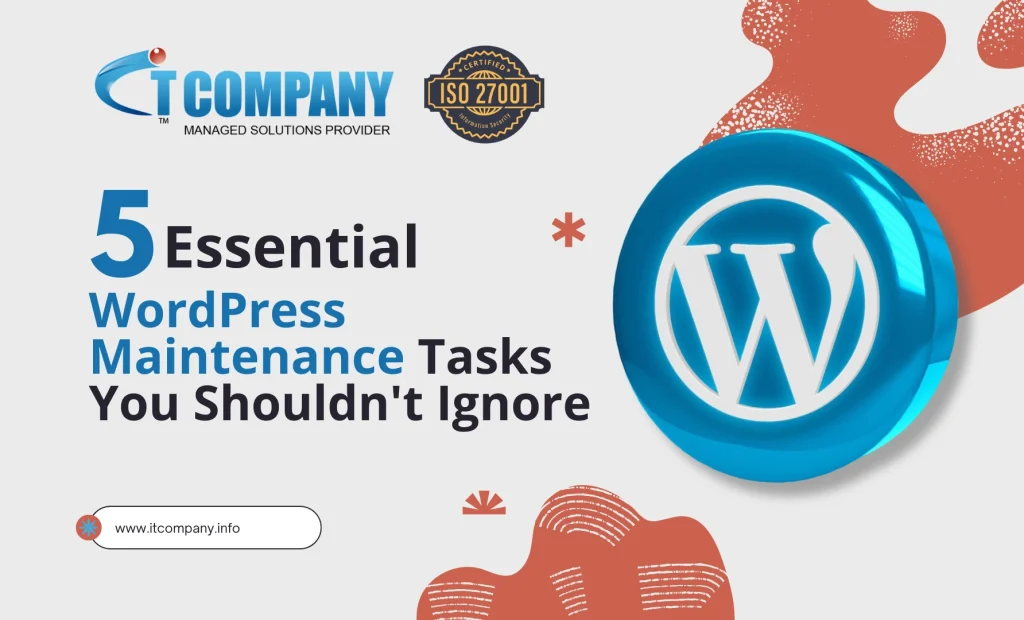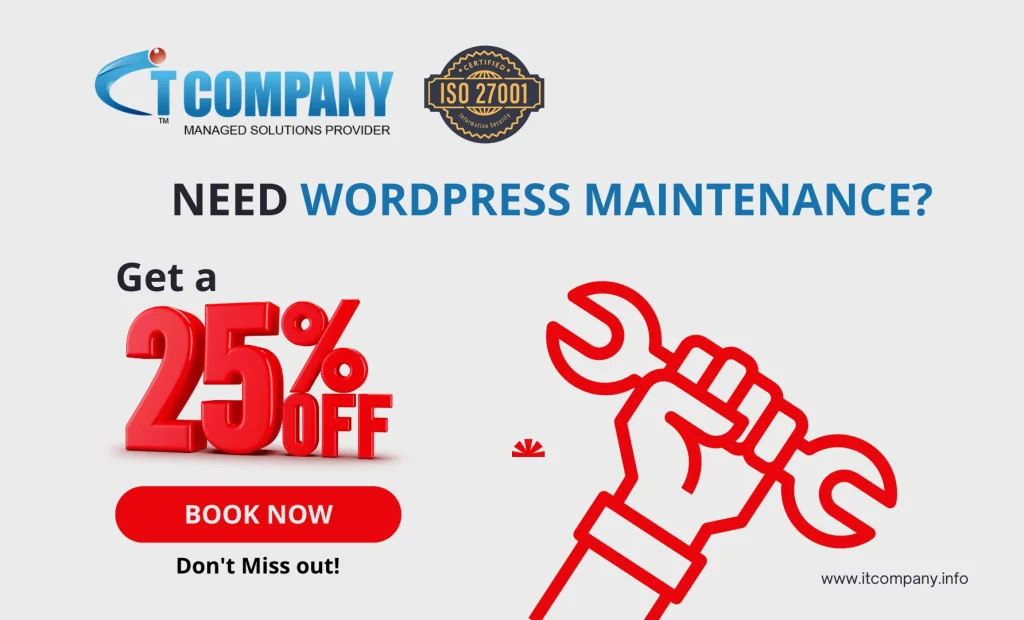
WordPress web maintenance is crucial to ensure optimize security performance and better user experience. Regular updates, backups and optimization keeps site running smoothly and reduce the risk of downtime, website hacking and slow page loading times.
IT Company offers top 5 WordPress web maintenance services to ensure optimize security performance. These include regular updates, backups and SEO optimization etc. Let’s explore these features one by one.
Table of Contents
Toggle1. Regular Software and Plugin Updates
It is very important to keep your core WordPress hosting site maintenance updates on regular basis. Updates include software, themes that you use, and plugins and widgets to date. WordPress frequently release updates such as security patches and new feature updates.
Third-party apps, plugins and themes also release updates to fix bugs and improve performance and added functionalities. Never neglect or ignore these core updates as it leaves your site open to security risks, compatibility issues and other problems.
Action Item:
- Enable automatic updates for minor WordPress versions.
- Manually update themes and plugins regularly, especially after a major release or security alert.
- Review your plugins list—remove any outdated or unused plugins to reduce the risk of security vulnerabilities.
2. Regular Backups
Backing up your website is an essential part of any maintenance strategy. In the event of a technical failure, hack, or human error, having a recent backup can save you hours or even days of work. A backup allows you to restore your site to its previous state quickly, minimizing downtime.
It’s important to schedule automatic backups regularly, ideally daily or weekly, depending on how frequently your site is updated. Backups should be stored in multiple locations, such as on a AWS cloud server, external drive, or a dedicated backup service.
Action Item:
- Use reliable backup plugins such as UpdraftPlus or BackupBuddy to automate backups.
- Store backups in multiple locations to ensure you can restore your site in case of an emergency.
- Test your backup restoration process to confirm that it works properly.
3. Optimize Site Performance
A slow website can drive away visitors and hurt your SEO rankings. Site speed is a crucial factor for both user experience and search engine optimization (SEO). Regularly optimizing your site’s performance should be a part of your WordPress maintenance routine.
You can improve your site’s speed by reducing the size of images, using caching, and optimizing your website’s database. Tools like Google PageSpeed Insights or GTMetrix can help you identify areas that need improvement, such as large image files, render-blocking JavaScript, or unnecessary plugins that slow down your site.
Action Item:
- Compress and optimize images before uploading them to your site.
- Use a caching plugin like W3 Total Cache or WP Super Cache to speed up page load times.
- Optimize your WordPress database using plugins like WP-Optimize to clean up unnecessary data.
4. Check for Broken Links
Broken links can negatively impact your website’s SEO and user experience. When visitors click on a broken link, they’re redirected to a 404 error page, which can frustrate users and increase bounce rates. Additionally, search engines like Google may lower your rankings if they find too many broken links on your site.
Running regular checks for broken links ensures that visitors have a smooth, uninterrupted experience on your site. You can use tools like Broken Link Checker or Google Search Console to find and fix broken links.
Action Item:
- Regularly scan your site for broken links using tools like Broken Link Checker or Screaming Frog.
- Fix or redirect broken links to the appropriate pages to improve SEO and user experience.
5. Monitor Website Security
Website security is a top priority for WordPress site owners. Hackers often target WordPress sites due to its popularity, so you must take steps to safeguard your website from threats like malware, data breaches, and brute force attacks.
Regularly monitoring your website for security issues and vulnerabilities can help you identify potential threats before they cause damage. You should also implement security measures such as strong passwords, SSL certificates, and two-factor authentication.
Action Item:
- Use security plugins like Wordfence or Sucuri to monitor and protect your site from threats.
- Implement an SSL certificate for secure data transmission and better SEO ranking.
- Regularly check for malware and vulnerabilities and address any security issues promptly.

Conclusion
Maintaining your WordPress website is an ongoing task that should not be overlooked. By regularly updating your site’s software, performing backups, optimizing performance, checking for broken links, and monitoring security, you’ll ensure that your site remains secure, fast, and user-friendly. Prioritizing these essential tasks will not only improve the overall experience for your visitors but also safeguard your business’s online presence.




